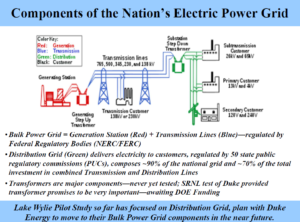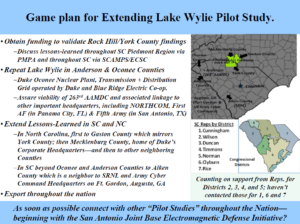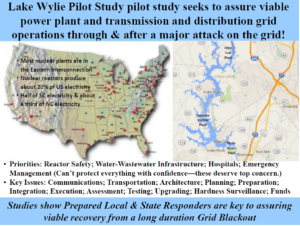“Critical infrastructure keeps our food fresh, our houses warm, our trade flowing, and our citizens productive and safe. The vulnerability of U.S. critical infrastructure to cyber, physical, and electromagnetic attacks means that adversaries could disrupt military command and control, banking and financial operations, the electrical grid, and means of communication.” ~President Donald J. Trump, December 18, 2017 National Security Policy
After the National Security Council staff led an interagency effort, President Trump’s March 26, 2019 Executive Order directed the Federal Government to develop an integrated plan to counter the existential electromagnetic pulse (EMP) threat. Then Wisconsin Senator Ron Johnson’s Amendment to the 2020 National Defense Authorization Act strengthened it, and when President Trump signed the NDAA(2020) on December 26, 2019, it became the “law of the land.”
Thus, President Trump and Congress have agreed and written into law on the need to address this critical vulnerability. And we know how it can be accomplished, at least technically. What is now needed is a specific game plan to achieve that objective. (Notably, while protecting against EMP, contingency plans should also include other threats, such as the near-term impact on grid operations by COVID-19 and follow-on COVID-19 events — and future physical or cyber attacks.)
The Lake Wylie Pilot Study in York County, SC has demonstrated that we can employ methods used for decades in protecting our most important military systems to protect our critical civil infrastructure — and for quite affordable cost. The only serious inhibitions are bureaucratic and the lack of funding to demonstrate this claim’s validity and to develop a viable plan to extend those lessons to other cities, counties and states.
As discussed below, the National Guard can and should play an important role in protecting the American people against this threat — they can get involved quickly by exploiting their existing responsibilities, illustrated by their fight against COVID-19. Click here for an informative report that over 43,000 Guardsmen are in this fight.
So, they de facto are already fighting the threat to those who operate and manage the electric power grid, arguably our most important civil infrastructure, as illustrated in my last week’s message. COVID-19 Phase 4 funding can also enable the Guard to assure we are prepared for and can respond effectively to other existential threats to the national grid. And we know how this can be done.
Click here for previous messages that have dealt with the Lake Wylie Pilot Study, which can provide a vehicle to enable such a response. Needed is $30 million to validate cost estimates that about $100/citizen can provide initial hardening and about $10-per-year/citizen can provide a hardness assurance/maintenance program to assure the hardened “Distribution Grid” is maintained — and to plan extensions of those lessons-learned to other South and North Carolina counties and beyond.
Additional funds are needed to enable South Carolina’s Adjutant General and associated state-wide National Guard operations — under oversight of Washington’s top National Guard authorities to extend this template even further. South Carolina’s Adjutant General and his staff have been involved in the Lake Wylie Pilot Study from its beginning and are prepared to play such a role in providing a pattern that others can follow.
The below figure describes the key components of the electric power grid, highlighting that the nation’s Distribution Grid composes over 90-percent of the national grid — and 70-percent of the cost of the its Transmission and Distribution lines delivering electricity to the American people. Click here for a recent briefing to a key Department of Homeland Security staff member with participation from all the key leaders of York County and our partner Duke Energy. It includes a detailed breakdown of the above cost estimate.
Congress reportedly is preparing a new stimulus package, referred to as Phase 4, to help revive the U.S. economy. President Trump has said Phase 4 should focus on critical infrastructure and provide meaningful work for the unemployed — perhaps like the Civilian Conservation Corp (CCC) in the 1930s that helped the nation recover from the Great Depression by providing work important to the nation. A CCC-like Phase 4 thrust, beginning in 2020, could improve the resilience of our electric power grid, arguably our currently vulnerable and most important critical civil infrastructure, since essentially everything else depends on it.
Several senior senators and representatives have referred to Phase 4 appropriately funding such an infrastructure initiative, but usually associated with roads and bridges — as was a major CCC focus. It should be understood that many “jobs” would be associated with activities needed to upgrade and protect the electric power grid — involving more electrical engineering than civil engineering, which underpinned the CCC activities of the 1930s.
For example, we should be building the industrial base for producing and protecting the Extra High Voltage (EHV) Transformers that are essential to our grid operations — and are not built in the United States. They require months to hand-produce in Germany and South Korea for thousands of distinctive substations throughout the nation — after being shipped from abroad. And we have too few stockpiled. American ingenuity can and should do better!
Moreover, we have never even tested any of these critical components of the electric grid upon which our survival literally depends.
One that Duke Energy (our partner in the Lake Wylie Pilot Study) gave for testing has been sitting idle (and deteriorating) for well over a year in North Charleston, SC — awaiting funds to ship this enormous, locomotive-size transformer, up the Savannah River for testing at the Savannah River National Laboratory, for the lack of less than a million dollars.
More is required for comprehensive testing when if ever Washington sends needed funding. And this testing capability should be extended and joined in a national effort to better evaluate and improve all such key components of the electric power grid.
Other concerns are associated with assuring the viability of the community of critical operators/operations that are essential to the viability of the grid. Numerous small companies can be employed and empowered to protect and sustain the complex grid that consists of 3000-4000 municipal and cooperative electric companies that own, maintain and manage grid operations. It is a top priority engineering and management problem.
The figure below illustrates how we propose to extend our Lake Wylie Pilot study lessons-learned to address these complexities within South Carolina, which involves three major power generation companies and 40 municipal and co-op electrical companies that supply electricity to the citizens in the “quilt’ of 46 counties illustrated below. All counties must deal with essential operations “from the bottom up.” Once effectively hardened, I think the Governor should charge the National Guard to execute a hardness assurance program (with spot inspections) to regularly assess the operational status of the diverse components of the state’s complex grid operations. Every state needs a similar effort.
Rock Hill’s Assistant City Manager, an Electrical Engineer, opened his Distribution Grid for a competent assessment and, as President of the Piedmont Municipal Power Agency (PMPA), will help export the Lake Wylie Pilot Study lessons-learned to the other nine PMPA cities in northwestern South Carolina, Rock Hill’s Chief Engineer is Vice President of the South Carolina Association of Municipal Power (SCAMP) and will help export those lessons-learned to South Carolina’s other 10 Municipal Power Companies. And the President of the York Electric Co-op also was very cooperative in opening his Distribution Grid for a competent assessment and will help export Lake Wylie Pilot Study lessons-learned to the other 19 Electric Cooperatives of South Carolina (ESSC).
The electric power grid is vulnerable to both natural and manmade threats. Of these threats, the most important, in my opinion, is EMP from a high-altitude nuclear weapon attack, or from the Sun, called a Geomagnetic Disturbance (GMD), that will one day occur. If we protect the grid from the manmade EMP threat, it will also be protected from the natural GMD threat — the converse is not true.
Furthermore, the EMP threat is explicitly included in the Military Doctrine of Russia, China, North Korea and Iran — so we continue to ignore it at our national peril. As the Congressional EMP Commission observed, an EMP attack could shut down the grid indefinitely, returning us to an 18th century existence without the agricultural benefits of that time, and most Americans could die from starvation, disease and societal collapse.
As noted by President Trump’s December 18, 2017 statement, the grid must also be protected from cyber and physical attacks — and some would place greater emphasis on the cyber threat than EMP. That was the view of Ted Koppel, who captured the essence of the problem and the challenge to solving it, whether the threat to the Grid comes from Cyber, Physical or EMP attacks on pages 231-2 of his 2016 book, Lights Out.
Most notably he argued that, given the Federal-State-Local “chain-of-command issues” and the legacy of “posse comitatus” constraints, the burden for protecting the average citizen will fall on the local community and its preparedness:
“In anticipating the event of a power grid going down . . . the process will have to be streamlined and rehearsed. During the time that it takes to alert and dispatch military personnel and to mobilize the National Guard, local and state police will need to immediately secure the stores and warehouses containing essential supplies that will otherwise be stripped bare in a matter of hours. The authority exists, but without the regular conduct of combined exercises specifically designed to respond to the aftermath of a grid going down, critical supplies will be gone before law enforcement even arrives on the scene . . .”
Koppel echoed my earlier perspective in approaching Clemson’s Electrical Engineering Department Chairman for contacts with his Duke Energy Graduates — leading to our cooperative Lake Wylie Pilot Study effort, about which I have reported many times over the past five years. Moreover, we have included not only key local civil authorities of Rock Hill and York County, but also South Carolina’s Adjutant General and Director of Emergency Management in all our key activities from the beginning to assure that they and their key staff have known of our efforts so they can include that knowledge in their plans and operations.
Click here for my May 4, 2017 testimony before the Senate Energy and National Resources Committee recommending the bottom up approach that I am now even more convinced is essential if we ever want to correct this existential threat to all we hold dear. At the conclusion of that important hearing, Chairlady Lisa Murkowski agreed when she stated:
“I appreciate the urging that we not let our guard down … recognizing that this [threat] is complicated and multifaceted … truly daunting … and that we need to start out locally … It is important that we in congress be reminded of the urgency and imperative of our task and I think we were given that message this morning.” (Emphasis added) ~ Senator Lisa Murkowski (R-AK)
We are now prepared, with Federal support from those South Carolina authorities, to validate our Lake Wylie Pilot Study results and begin to employ those lessons-learned throughout South Carolina and beyond.
In my view, the National Guard should be the focus of that planning and associated operations, by employing and extending as appropriate its already existing authorities and responsibilities — especially as included in the mission of the national Civil Support Team (CST) operations. These CST teams were originally formed in 1998 to help counter threats from weapons of mass destruction (WMD) — most notably from Chemical, Biological, Radiological and Nuclear threats. Every State has at least one CST (New York, California and Florida have two CSTs), that is funded by the Federal Government and they operate under direction of the Nation’s 50 Governors.
Click here for a Wikipedia discussion of the CST history and operations. I argue that this background sets a sound stage for the nation’s CSTs to be exploited with an appropriately extended mission to include developing the necessary “bottom-up” assessment processes and procedures needed to protect the nation from the existential EMP threat. Below is a pertinent excerpt (with my underlined emphasis added) from this Wikipedia article:
The mission of the WMD-CST is to support civil authorities at the direction of the Governor, at domestic CBRN incident sites by identifying CBRN agents/substances, assessing current and projected consequences, advising on response measures, and assisting with requests for additional support. In the National Defense Authorization Act (NDAA), Fiscal Year (FY) 2007, Congress expanded the operational incidents a WMD-CST could be used to include the intentional or unintentional release of CBRN and natural or man-made disasters in the United States that result, or could result, in the catastrophic loss of life or property.
The WMD-CSTs are National Guard units designed to provide a specialized capability to respond to a chemical, biological, radiological or nuclear (CBRN) incident primarily in a Title 32 operational status within the United States, the District of Columbia, its territories and possessions, as established by 10 USC §12310. Congress, the President, and DoD recognized that the WMD-CSTs, {responding under the authority of the Governor (Only for the National Guard)}, provide significant capabilities to assist local and state agencies that may be overwhelmed by a large-scale terrorist attack or where specific technical capabilities to identify CBRN materials are required. In October 1998, Congress authorized and funded the fielding of the first 10 WMD-CSTs. With this fielding began the development and evolution of new capabilities and concepts to ensure that DoD could support evolving interagency response plans. Since 1998, Congress has authorized and funded the fielding of WMD-CSTs in the remaining States and territories.
The WMD-CST consists of 22 National Guard Soldiers and Airmen, in Full-Time duty status; also known as Active Guard/Reserve (AGR) status. The unit consists of six (6) sections: command, operations, administration/logistics, medical/analytical, communications, and survey. The WMD-CST is required to maintain a level of readiness that will allow for a rapid response within established timelines. The unit is specially trained and equipped to assist local, tribal, state, and Federal emergency response organizations with state of the art equipment. They also have a technical and analytical reachback capability to other experts who may assist the local response.
The certified WMD-CSTs provide unique capabilities, expertise, and technologies to assist the governors in preparing for and responding to a CBRN situation. These WMD-CSTs are available 24 hours a day, 7 days a week for rapid deployment for response operations. The WMD-CST complements and enhances local and State capabilities. In order to ensure that the WMD-CSTs are capable of a sustainable, rapid response in support of a validated request for assistance, the following response management plan outlines a standardized approach to provide WMD-CST support anywhere in the United States. The WMD-CST is manned, trained, and equipped to conduct continuous operations for a minimum of 72 hours using organic table of distribution and allowances (TDA) assets. If extended operations, past 72 hours are required, additional WMD-CSTs will be alerted to provide augmentation or relief. Codified as the Response Management Plan (RMP), this document ensures that a designated number of WMD-CSTs are always ready to respond to a national need, or to fill a request of a State without an available WMD-CST. A primary planning assumption is that each JFHQ-State is best informed to create contingency plans for WMD-CST coverage within its jurisdiction. Therefore, this plan is intended to be activated only when a specific support request is received at the NGB Joint Coordination Center (JoCC). NGB initiated operational support requests will be the exception. WMD-CSTs support over 2500 events annually conducting counter WMD activities.
I believe that top priority Phase 4 funding should support the South Carolina Adjutant General in developing specific plans and operations to validate and extend our Lake Wylie Pilot Study lessons-learned throughout South Carolina and beyond as previously discussed numerous times. As illustrated below, this follow-on activity will give top priority to working with Duke Energy to protect our nuclear power reactors a top priority.
The Lake Wylie Pilot Study in York County, SC has already demonstrated that we can employ methods used for decades in protecting our most important military systems to protect our critical civil infrastructure — and for quite affordable cost.
The only serious inhibitions are bureaucratic and the lack of funding to demonstrate this claim’s validity and to develop a viable plan to extend those lessons to other cities, counties and states.
As stated earlier, needed is $30 million for York County leaders to validate cost estimates that about $100/citizen can provide initial hardening and about $10-per-year/citizen can provide a hardness assurance/maintenance program to assure the hardened grid is maintained — and to plan extensions of those lessons-learned to other South and North Carolina counties and beyond.
Beyond this $30 million is needed legislation and additional funds for South Carolina’s Adjutant General and associated state-wide National Guard operations — under oversight of Washington’s top National Guard authorities to extend this template even further.
If validated, our initial cost estimates suggest that protecting the Nation’s Distribution Grid to protect the 330 million folks living here would be $33 billion, plus the operating costs of the CSTs in our fifty states.
The thus-funded York County “bottom-up” plan should include developing and extending a more general plan to protect effective operations of the grid under all hazards, and especially from a second and even a third wave of COVID-19 before a vaccine is ready. Objectives would include to:
- Protect nuclear power plants and especially their spent fuel pools by ensuring that the nuclear reactors remain safe in a blackout, and can be restarted to provide power, even if the electric power grid fails.
- Protect critical parts of the electric grid to assure the viability of top priority infrastructure, including vital water-wastewater operations and essential emergency management communications.
- Tie via the National Guard to other pilot studies such as in San Antonio, Texas, including military bases and key community operations—in concert with national and state regulatory authorities and in conjunction with major energy companies like Duke Energy, a key Lake Wylie Pilot Study partner from the beginning.
Bottom Lines.
I often quote Senator Ron Johnson (R-WI), chairman of the Senate Homeland Security and Governmental Affairs Committee, who notably closed an important hearing by observing:
“We have known about the existential threat posed by electromagnetic pulses (EMP) and geomagnetic disturbances (GMD) for decades. Because most people are either unaware of the danger, or view these as very low probability events, there has not been sufficient public pressure to take effective action to mitigate these threats. Instead, we establish commissions and study panels, conduct research, and develop plans to develop strategies. It is way past time to stop admiring this problem, and actually begin to do something concrete to protect our vulnerable electrical grid, control systems, and the ever-increasing array of electronic devices our society has become dependent upon.”
Hopefully, South Carolina’s senior Senator Lindsey Graham will lead in sponsoring Phase 4 appropriations to “Fix the Grid” from the bottom up, with our Lake Wylie Pilot Study playing a key role. And other leaders in the Senate and House will follow suit. This would be the “concrete” plan that Senator Johnson urged us to pursue.
What can you do?
Join us in praying for our nation, and for a rebirth of the freedom sought, achieved and passed to us by those who came before us.
Help us to spread our message to the grass roots and to encourage all “powers that be” to provide for the common defense as they are sworn to do.
Begin by passing this message to your friends and suggest they visit our webpage www.highfrontier.org, for more information. Also, please encourage your sphere of influence to sign up for our weekly e-newsletter.
Encourage them to review our past email messages, posted on www.highfrontier.org, to learn about many details related to the existential manmade and natural EMP threats and how we can protect America against them. I hope you will help us with our urgently needed efforts, which I will be discussing in future messages.
Click here to make a tax deductible gift. If you prefer to mail a check, Please send it High Frontier, 20 F Street 7th Floor, Washington, DC 20001.
Please click here to read Past Weekly Updates!
Please help High Frontier continue this important and timely work!
Be sure to follow us on our Social Sites!
If you found this letter via our Social Sites, and you would like to subscribe, please click below!








